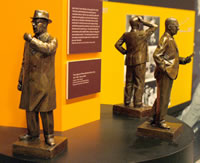John Curtin
John Curtin was born in the Victorian mining town of Creswick on 8 January 1885.
He was the oldest son of Irish immigrants, Kate and John Curtin.
Curtin's much interrupted education ended when he began work at 14 to supplement the family income with a number of different jobs.
Curtin became Secretary of the Timber Workers Union in 1911 and within two years had coordinated a loose association of local groups into a tight and effective union. He was instrumental in the introduction of a Workers' Compensation Act in Victoria.
On a working trip to Hobart in 1912 Curtin met Elsie Needham and the couple formed a lasting friendship, corresponding regularly over the next few years.
During World War One Curtin was a staunch anti-conscriptionist and in 1916 was appointed secretary of the National Executive of the Anti-Conscription Campaign.
In 1917 he became editor of the Westralian Worker, the official paper of the WA Labor Party, and moved to Perth to start a new life.
Soon after establishing himself in Western Australia, Curtin married Elsie Needham and they had two children
In 1928 Curtin stood for and won the federal seat of Fremantle. He lost the seat when the Labor Government was defeated in 1931, but regained it in the 1934 election. When James Scullin resigned as leader of the Australian Labor Party in October 1935, John Curtin was elected to the position by one vote.
When the previous government collapsed, Curtin became prime minister on 7 October 1941, just two months before the bombing of Pearl Harbour and the start of the Pacific war.
John Curtin died in office on 5 July 1945.
JCPML. Records of the Australian Labor Party WA Branch. JCPML00379/2
JCPML. Records of the Curtin family. JCPML00004/9

JCPML. Records of the Curtin family. JCPML00382/58








.jpg)

.jpg)
.jpg)
.jpg)
